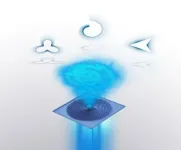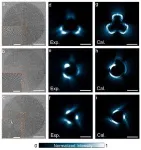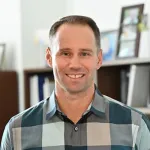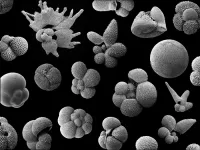A new publication from Opto-Electronic Advances; DOI 10.29026/oea.2024.230184 , discusses tailoring electron vortex beams with customizable intensity patterns by electron diffraction holography.
In recent years, the scientific community has witnessed a notable breakthrough in the study and development of electron vortices. Electron vortices are electron beams that carry orbital angular momentum, meaning the electrons move not only in their propagation direction but also rotate in a vortex-like manner. This unique characteristic offers many new physical properties and potential applications, making it a powerful tool in exploring microscopic structures and physical properties of materials, especially in fields like chiral energy loss spectroscopy and magnetic dichroism spectroscopy.
The study of electron vortices is driven by a deeper understanding of fundamental particles, such as photons and electrons. In 1992, Allen and others discovered that light beams could carry quantized orbital angular momentum, laying the theoretical foundation for electron vortex technology. Electrons, as charged particles, exhibit wave-like behaviors similar to photons, allowing them to be manipulated and shaped like light waves to generate vortex characteristics. The development of electron vortex technology stems from exploring and utilizing these wave-like properties of particles.
Since the first successful creation of electron vortices in 2010, this field has undergone significant development. Initially, electron vortices were generated using spiral phase plates composed of spontaneously stacked graphite films to impart orbital angular momentum to incident electron beams. Scientists later explored various methods to generate electron vortices, such as holographic masks, magnetic lens aberrations, and magnetic needles. These techniques not only produce electron beams with specific orbital angular momentum but also manipulate the interactions of electron vortices with matter and external electric and magnetic fields. Despite the significant progress in the concept and application of electron vortices, traditional vortices have limitations in their intensity modes, typically presenting isotropic circular ring patterns. This limitation is due to the constant phase gradient distribution of the electron beam, restricting the diversity of electron beam shapes and limiting the potential applications of electron vortices.
The authors of this article have created structured electron vortices with non-homogeneous intensity distributions based on the relationship between the local divergence angle and azimuthal phase gradient of electron beams. This breakthrough means that the intensity patterns of electron vortices can be customized according to specific needs, opening new dimensions for the manipulation and application of electron beams.
The authors demonstrated how to adjust incident free electrons in a transmission electron microscope using computer-generated holograms and designed phase masks to produce structured electron vortices with different intensity patterns. This method allows researchers to create electron vortices with various intensity patterns, such as cloverleaf, spiral, and customized arrow shapes, each carrying the same orbital angular momentum. The study reveals that although these electron vortices can be quantified macroscopically by a single integer describing their global topological invariance, microscopically, they are actually a superposition of different eigenstates resulting from locally varying geometric structures. This discovery is significant for understanding and applying electron vortices.
Another important achievement of this research is the exploration of the coherent superposition states of structured electron vortices. By designing phase masks to generate structured electron vortices with different topological charges, the experiment successfully produced superposition states with different intensity distributions. These states exhibited unique petal-shaped interference patterns, confirming that despite being composed of a series of discrete orbital angular momentum modes microscopically, the coherent superposition states of structured electron vortices still depend on their global topological invariants.
This study not only broadens the theoretical understanding of electron vortices but also demonstrates experimentally the feasibility of controlling their intensity modes by manipulating the local structure of the electron beam. Thanks to its additional controllable degree of freedom, the structured electron vortices as a quantum electron probe holds great potential in electron microscopy and can further promote various in-situ applications, such as electron manipulation of nanoparticles along designed trajectories, pattern-dependent interaction of electron orbital angular momentum with matter, and selectively exciting and probing surface plasmon modes. The structured electron vortices also can be directly used in lithography to produce shaped nanostructures without the need to scan the beam. Moreover, such concepts and generation approach are convenient to generalize to other particle systems, such as neutron, proton, atom and molecule. This provides new perspectives and methods for further research and applications of particle beams.
Article reference: Huo PC, Yu RX, Liu MZ et al. Tailoring electron vortex beams with customizable intensity patterns by electron diffraction holography. Opto-Electron Adv 7, 230184 (2024). doi: 10.29026/oea.2024.230184
Keywords: electron vortex beam / orbital angular momentum / diffraction holography
# # # # # #
Prof. Lu Yanqing is the Vice Principal of Nanjing University, Changjiang Scholar Distinguished Professor, winner of the National Science Fund for Distinguished Young Scholars, and the leader of the innovation team of the Ministry of Education. His research mainly focuses on dielectric superlattices, liquid crystal materials, fiber optics and many other fields, and he has international influence in the research fields of ionic phononic crystals, liquid crystal materials and their optoelectronic applications. He has published more than 300 papers in journals such as Science, Science Advances, Nature Nanotechnology, and Nature Communications, and has more than 20,000 citations.
Prof. Xu Ting is a doctoral supervisor at the School of Modern Engineering and Applied Science, Nanjing University, and a national high-level talent. His main research interests are micro-nano optics, optical metamaterials and advanced micro-nano processing technology. So far, he has published more than 100 papers in journals including Nature, Nature Nanotechnology, Nature Communications, Science Advances, Physical Review Letters, Nano Letters, etc.
# # # # # #
Opto-Electronic Advances (OEA) is a rapidly growing high-impact, open access, peer reviewed monthly SCI journal with an impact factor of 14.1 (Journal Citation Reports for IF2022). Since its launch in March 2018, OEA has been indexed in SCI, EI, DOAJ, Scopus, CA and ICI databases over the time, and expanded its Editorial Board to 30 members from 17 countries.
The journal is published by The Institute of Optics and Electronics, Chinese Academy of Sciences, aiming at providing a platform for researchers, academicians, professionals, practitioners, and students to impart and share knowledge in the form of high quality empirical and theoretical research papers covering the topics of optics, photonics and optoelectronics.
# # # # # #
More information: http://www.oejournal.org/oea
Editorial Board: http://www.oejournal.org/oea/editorialboard/list
All issues available in the online archive (http://www.oejournal.org/oea/archive).
Submissions to OEA may be made using ScholarOne (https://mc03.manuscriptcentral.com/oea).
ISSN: 2096-4579
CN: 51-1781/TN
Contact Us: oea@ioe.ac.cn
Twitter: @OptoElectronAdv (https://twitter.com/OptoElectronAdv?lang=en)
WeChat: OE_Journal
# # # # # #
END




